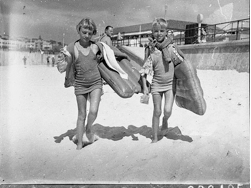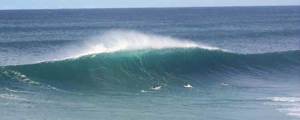surfoplanes ~ their place in the scheme of things

Not enough has been written about the Surfoplane, particularly in regard to its legitimate role as a precursor to the hard-edged BellyBoard and the modern day Boogie Board, and nothing at all has been written about the techniques and skills necessary to have had a successful session on a surfoplane in 1957 at Bondi.

NSW STATE LIBRARY-HOOD COLLECTION
CHOOSING THE EQUIPMENT
Stan Macdonald held the Bondi franchise for renting black surfoplanes and Al Baldwin the one for spraying women with his toxic mixture of perfume, coconut oil and paraffin. Suntan Al invented an art form out of spraying the men and women who lined up for a top to toe grease and oil cover from his hand-held spray gun.
He made the ladies pirouette and bend this way and that, and the prettier the girls were the more dry spots Al found on them he could only apply the mixture with his large hairy hands. He was a popular man with the club members was Stan, many of whom ranged their deckchairs around his perfumed patch on the sunny weekends – just browsing.
Rumour had it that the spray gun was replaced free of charge every year by Mr. Gelignite Jack Murray, noted Bondi garage owner, Redex operative, ladies man and dynamite handler.
A decade after Al departed the smell of his infamous concoction could be resuscitated by digging just a foot or two into the sand just below the Shark Tower, particularly in winter.
A melancholy exercise.
Stan’s job was to rent surfoplanes by the half-hour to anyone who wanted to paddle out into the surf. These transactions were done over the counter of one of the dugouts under the promenade and a good deal of caution was necessary before any money was handed over as Stan was not one given to an exchange of product once the money was in his pocket.
Unfortunately some of Stan’s product proved unstable (leaking air), structurally unsound (blown dividers, dodgy handles), incomplete (lacking handles), or unable to be refilled at critical times (degenerated bung). This detailed product inspection by customers aged about thirteen to fourteen did not sit peaceably with Stan and there were times when a morose distemper settled heavily upon him and he shouted everybody away. These may well have been early days, but we had our shit together.
Stan however remained ignorant of these basic customer requirements for the life of his business, which did not surprise any of his youthful clientele, seeing as he was once a Beach Inspector and close colleague of Aub Laidlaw. Though we do owe him, and Aub, for a lifelong aversion to discipline and conformity.

PADDLING OUT
Surfoplanes were primarily designed to float one person and be pushed onto broken waves so that small children could be thrilled by the favourable experiences of speed and glide to the shore on a broken wave.
Hardly Hawaiian but close enough in 1956, and after every successful ride Dad would grab the handles and drag junior out again for another slide, and then another, and another again.
Then one day when the sea was breaking a little bigger than usual, and while the children slept through the midday heat under the shade of a beach umbrella, their father wandered away towards the flags with the Surfoplane under his arm, unhearing yet subliminally aware of the call of that great seducer – the lissome song of a breaking wave – so not for him this day were the fallow remnants of an inshore wash.
But how to get out there?
Chuck it over? Push it under? Catch it in and wait? Or just bash through?
Chucking the thing over was always a reasonable option, particularly if there was more than one surfer heading out at the same time and none of them had a firm recollection of the number painted on their surfoplane prior to the attempt.
For instance; five boys all throw their inflatables over and dive under the wave at the same time, when they surface there are only two items available for immediate collection in the near vicinity, and the missing three are speeding back to shore as fast as the wave can carry them. Speed was the key to an orderly retrieval here, and the fastest swimmer claimed the nearest and who’s going to argue when the next wall of whitewater is already here and looking for attention.
THE RIDE IN
Unlike today’s surfing etiquette, where only one man has the right of possession of a wave, fifty years ago it didn’t matter who was where, in fact the more who were able to crowd together on the very lip of a breaking wave the better. Especially if the wave had some size, because from this lofty crag the route to shore could be better planned.
For instance; five boys are poised on the edge of a six foot wall of water that is about to rear up even higher and collapse onto the sandbank, and in the few seconds available they are individually able to string together a logical and related series of moves that would rival the game plan of a chess master.
The inner sandbank was of course crowded with swimmers either too cautious to go beyond their depth, too inexperienced to tackle the dangerous breaking surf, or who were simply in a hasty retreat and trying to get out of the way. Whatever, young or old, now they were legitimate targets.
The proper technique to get up sufficient killer approach speed was for the surfoplane rider to deny fear and lean down over the lip and wait for the momentum of the wave to pitch the him down the vertical face into a long and fast glide that accelerated him well in front of the explosion of whitewater that always followed.
This was where subjective target consolidation became critical, given the victim rich environment that presented itself. Ricochets were much prized, as was the rare double-knock – where more than one rider hit the same floundering wallower. Happily the choices were endless and at times a low growl could be heard amongst the roar of the sea as the young attackers homed in on their prey.
Over there, a group of adolescent girls squealing with mock fright and trying to keep their hair dry, girls who had never bothered with fourteen year-old boys, until now.
Behind them an overweight man desperately waddling away from the fast approaching mass of whitewater, a quality target indeed and one that was sometimes the objective of more than a few of us, as we converged towards him with a sharklike hunger, a killing pack.
To the left a loving couple uncoupling their embrace far too late, then coupling again as the drama of the moment became evident – Two in the one hit. Quality targeting.
And of course there was always the chance of running down a mate who was trying to get back out for another sortie, and grabbing his surfoplane on the way through, a fair trophy.
So here was the very early breeding pool of the first generation of modern surfers, not unlike the dozens of snowy haired kids who infest our beaches today; all playing out there in seas that make fools of the weather forecasters, bewilder the sports columnists and frighten their parents.






And today, after decades of development by Paul Gross and Dale Solomonson, they have evolved into one of the most efficient wave riding craft available.
http://magictowelride.blogspot.com/2010/11/more-about-neumatic-advanced-20070-surf.html
not only does he go very fast, but he’s aggravated one bloke enough so he gets a board flicked at him, then he drops in on a couple of boardriders, and wins.
greenough was right
Being a mat rider and considered to be at the lowest branch in the tree I can understand how he may have needed to assert himself especially as it is his home break of many years too! Fast is an understatement!
A friend in Perth is out with a knee injury but managed to catch a few lying down the other day. Told him he needed a surfoplane. ‘That would be ace and very funny’ was the reply.
I can remember using that word ‘ ace ‘ about 3 times in 1968 – I think it was superceded by ‘ pope ‘ – asamatteroffact I don’t think anyone has ever done an anthropological study on the currency of surfing slang – There could be a thesis here and a degree in something useful – I could be as smart as Evers, or Nuttle
Onto something there Pete. Pope? Never heard that one.
What do you think? Could I use a hydro-slide like a boogie board? It is 51″ long and about 22″ wide but it is probably stiffer than a typical booogie board. Although the nose has good width it does not curve up quite as much as a body board. What about the dynamics of the bottom of a hydro slide on the waves? I am 6′ 5″ tall and weigh 210 lbs.
I am having a hard time finding an affordable body board that will accomodate me and this thin is on sale for $55. Please be frank.
Thanks,
Stuart on Galveston’s Gulf Coast.
You are a big unit Stu, big enough to convince the bloke to give you a test run – slide him $10 and take it for a wave – I’d be thinking of a 9’6″ mal though – anything else and you’re underwater.
Sounds like you need an XL from Paul Gross, Stu. Gonna cost you a little more than $55 but they are a 21st century customisable in real-time speed machine!
http://www.surfmats.com/xl.html
Awww man on a softie, Geraldton back beach, full on dumpin, my mates older brothers took us out, I will always remember the younge older brothers grin, next, a long barrel with all different appendages showing. Got used to it surfin Secret Harbour!, But scored a mini version, take it down the beach, skytin around like some one will notice! (got the boy’s name on it!).
well let me tell you about suroplane as i was one of the guys involved in the re introduction of them in 2002.
i know one has any idea how hard these are to make and that’s why even in the early days they was so expensive as they are completely made by hand as each section is hand cut and then foldded rolled with glue,how they get the chambers in side not to stick is a secret told to me by the last person involved in making them in the early days and then they are vulcanised,to watch the people in sri lankan make them was nothing but amazing.
i still today have so many phone calls from people trying to buy them it’s amazing.i meet with Dr Smithers daughter and she and her family was behind us 100% in bringing them back.
i don’t believe you will ever see these made again as the only rubber company with ovens large enough to vulcanise them has closed and it took us yrs to find him.paul woolmer